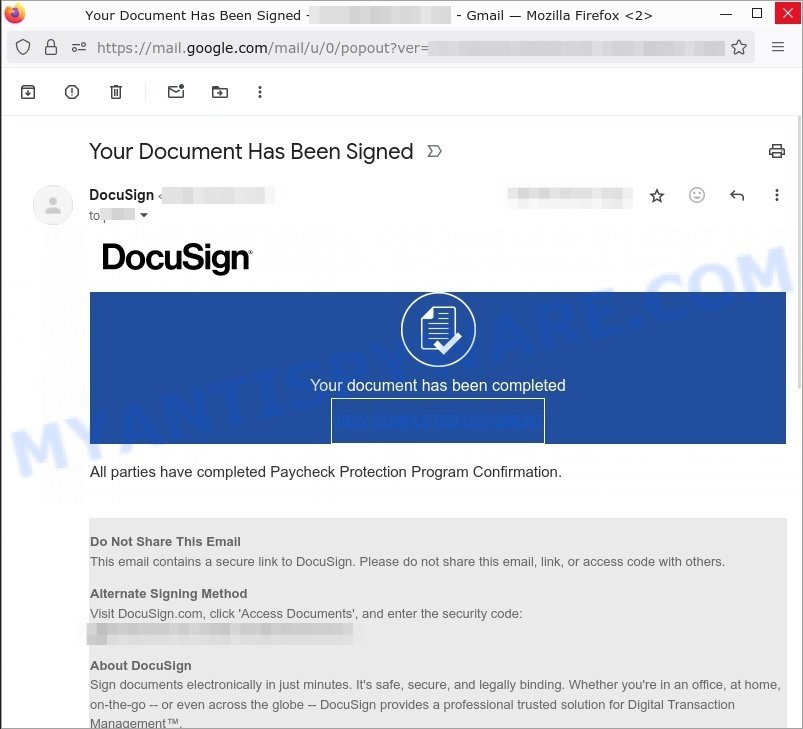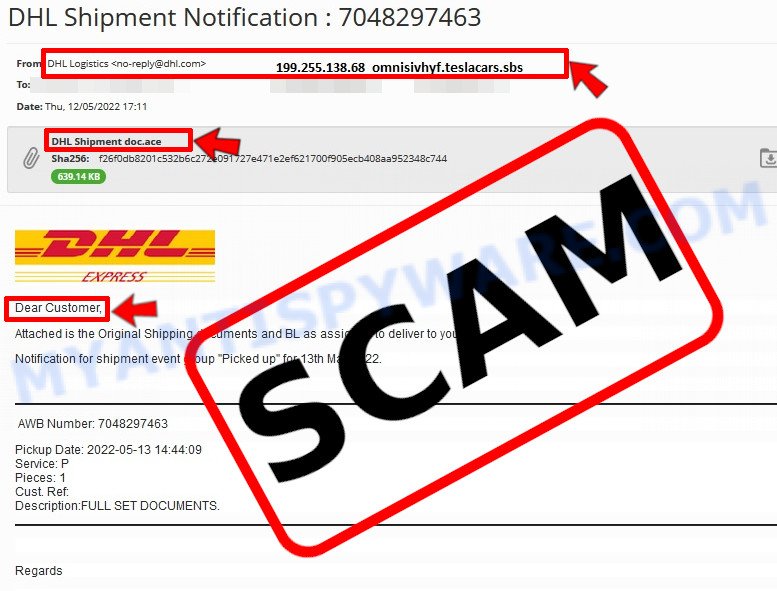Have you ever received an email saying “Your Document Has Been Signed” or something similar, showing that a document related to the Paycheck Protection Program has been completed?

Question: Is this message a legitimate DocuSign notification that I should act on, or is it something suspicious, like a scam?
Investigation Findings: This type of email often pretends to be from DocuSign, suggesting there is a completed document requiring your attention. It includes prompts to view the document or enter security codes, which can seem convincing.
Answer: This is a fraudulent email scam. 💡 To protect yourself from scams like this, always verify the sender’s email address and be cautious of unexpected requests to click on links or enter codes. Additionally, access your DocuSign documents by going directly to their official website instead of using email links. If uncertain, you can reach out directly to the supposed sender to confirm the request is real.
A typical “DocuSign Your Document Has Been Signed” scam email reads as follows:
Subject: Your Document Has Been Signed
Your document has been completed
VIEW COMPLETED DOCUMENTAll parties have completed Paycheck Protection Program Confirmation.
Do Not Share This Email
This email contains a secure link to DocuSign. Please do not share this email, link, or access code with others.Alternate Signing Method
Visit DocuSign.com, click ‘Access Documents’, and enter the security code:About DocuSign
Sign documents electronically in just minutes. It’s safe, secure, and legally binding. Whether you’re in an office, at home, on-the-go — or even across the globe — DocuSign provides a professional trusted solution for Digital Transaction Management™.Questions about the Document?
If you need to modify the document or have questions about the details in the document, please reach out to the sender by emailing them directly.If you are having trouble signing the document, please visit the Help with Signing page on our Support Center.
Download the DocuSign App
This message was sent to you by Doris Baker who is using the DocuSign Electronic Signature Service. If you would rather not receive email from this sender you may contact the sender with your request.
DocuSign Your Document Has Been Signed Email Scam overview
The DocuSign Your Document Has Been Signed Email is a scam that targets unsuspecting users. This email scam looks like a real message from DocuSign, saying that your document has been signed. It even includes links and security codes to make it look legit.
However, the links in the email can actually lead you to dangerous websites that try to steal your information or put harmful software on your device. Scammers use official-looking messages like this to trick you into clicking links or giving away personal info.
Summary Table
| Name | DocuSign Your Document Has Been Signed Email Scam |
| Type | Email Scam |
| Pretends to Be | DocuSign |
| Goal | Steal personal information or install malware |
| Method | Fake email with links |
| Recommendation | Do not click links and delete the email |
📧 What to Do When You Receive the “DocuSign Your Document Has Been Signed” Scam Email
We advise everyone who receives this email to follow the simple steps below to protect yourself from potential scams:
- ❌ Do not believe this email.
- 🔒 NEVER share your personal information and login credentials.
- 📎 Do not open unverified email attachments.
- 🚫 If there’s a link in the scam email, do not click it.
- 🔍 Do not enter your login credentials before examining the URL.
- 📣 Report the scam email to the FTC at www.ftc.gov.
If you accidentally click a phishing link or button in the “DocuSign Your Document Has Been Signed” Email, suspect that your computer is infected with malware, or simply want to scan your computer for threats, use one of the free malware removal tools. Additionally, consider taking the following steps:
- 🔑 Change your passwords: Update passwords for your email, banking, and other important accounts.
- 🛡️ Enable two-factor authentication (2FA): Add an extra layer of security to your accounts.
- 📞 Contact your financial institutions: Inform them of any suspicious activity.
- 🔄 Monitor your accounts: Keep an eye on your bank statements and credit reports for any unusual activity.
🔍 How to Spot a Phishing Email
Phishing emails often share common characteristics; they are designed to trick victims into clicking on a phishing link or opening a malicious attachment. By recognizing these signs, you can detect phishing emails and prevent identity theft:

💡 Here Are Some Ways to Recognize a Phishing Email
- ✉️ Inconsistencies in Email Addresses: The most obvious way to spot a scam email is by finding inconsistencies in email addresses and domain names. If the email claims to be from a reputable company, like Amazon or PayPal, but is sent from a public email domain such as “gmail.com”, it’s probably a scam.
- 🔠 Misspelled Domain Names: Look carefully for any subtle misspellings in the domain name, such as “arnazon.com” where the “m” is replaced by “rn,” or “paypa1.com,” where the “l” is replaced by “1.” These are common tricks used by scammers.
- 👋 Generic Greetings: If the email starts with a generic “Dear Customer”, “Dear Sir”, or “Dear Madam”, it may not be from your actual shopping site or bank.
- 🔗 Suspicious Links: If you suspect an email may be a scam, do not click on any links. Instead, hover over the link without clicking to see the actual URL in a small popup. This works for both image links and text links.
- 📎 Unexpected Attachments: Email attachments should always be verified before opening. Scan any attachments for viruses, especially if they have unfamiliar extensions or are commonly associated with malware (e.g., .zip, .exe, .scr).
- ⏰ Sense of Urgency: Creating a false sense of urgency is a common tactic in phishing emails. Be wary of emails that claim you must act immediately by calling, opening an attachment, or clicking a link.
- 📝 Spelling and Grammar Errors: Many phishing emails contain spelling mistakes or grammatical errors. Professional companies usually proofread their communications carefully.
- 🔒 Requests for Sensitive Information: Legitimate organizations typically do not ask for sensitive information (like passwords or Social Security numbers) via email.
✅ Conclusion
We hope this article has helped you understand more about the “DocuSign Your Document Has Been Signed” Scam Email and how to avoid falling victim to scammers. If you have received a phishing email that is similar but not identical to the example above, please post it in the comments section of this article. This helps us warn other users about potential scams and improve our resources to protect you better. Stay safe and vigilant! 🛡️

















